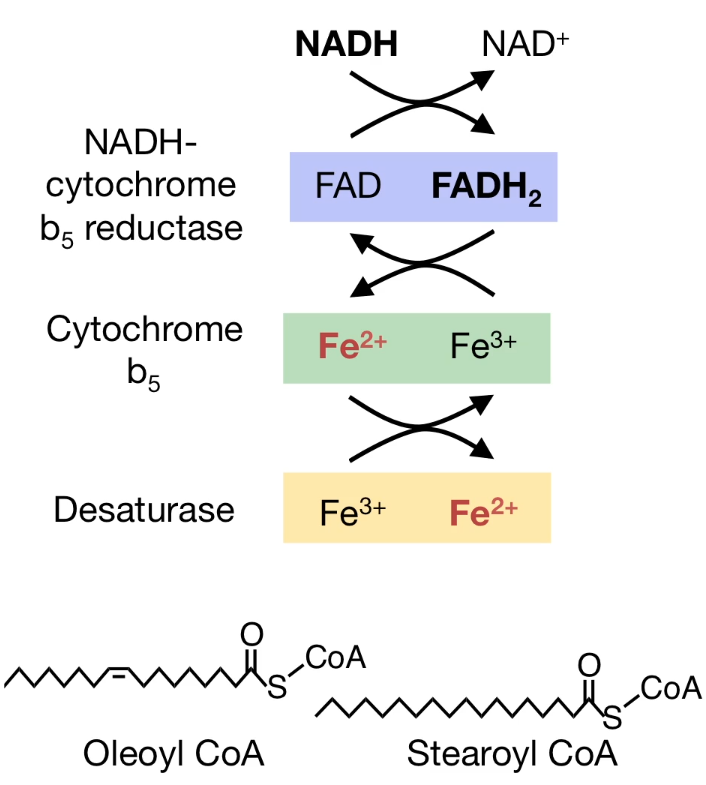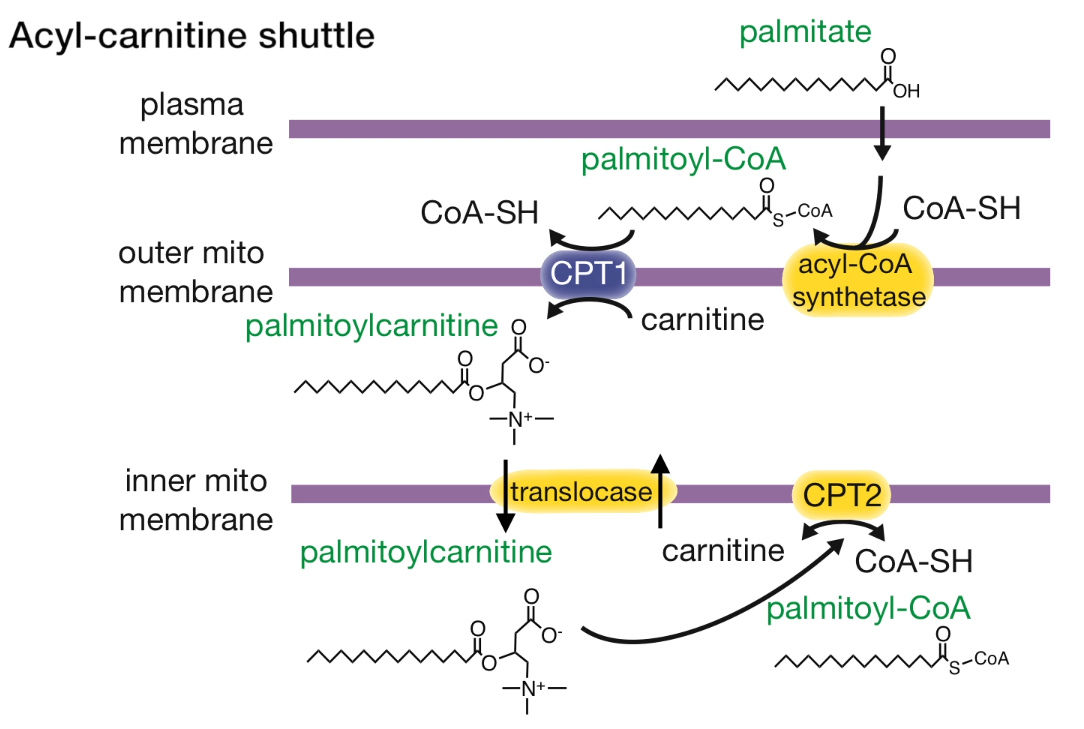Principles of Biochemistry 24 |Fatty Acid Metabolism| Class Notes |HarvardX
The Building block of the Fatty acid
$$
Acetyl-CoA + ATP + HCO^ - _3
\overset{ACC}{\longrightarrow}
malonyl-CoA + ADP
$$
ACC: Acetyl Coenzyme A Carboxylase
Fatty Acid Synthesis (FAS)
- A long single polypeptide chain
- few distinct domains with specific enzymatic activities.
- Domains are coordinated during fatty acid synthesis
As you can see, the ACP domain is at the center of the Enzyme
- $Acetyl-CoA \overset{MAT}{\longrightarrow} CoA-SH + Acetyl$
$Acetyl + KS \to Acetyl$-KS
MAT would cleavage of malonyl CoA
Three carbon malonyl group binds to ACP
ACP-malonyl(3C); KS-acetyl(2C) - A five steps reaction is going to join the group in KS and ACP domain
- Condensation (KS)
malonyl(3C)-ACP $\overset{decarboxylate}{\longrightarrow}$ (2C)-ACP + CO2
ACP-R(2C) + Acetyl(2C)-KS $\to$ ACP-R(4C) + KS-SH - Reduction (KR)
ketone group in R(4C) was removed by KR with the help of NADPH
ACP-R(ketone)+NADPH + H+ $\overset{KR}{\longrightarrow}$ ACP-R(hydroxyl) + NADP+ - Dehydration (HD)
ACP-R(hydroxyl) $\overset{HD}{\longrightarrow}$ ACP-R(C=C) + H2O
double carbon bond was formed and a water molecule was released. - Reduction (ER)
ACP-R(C=C) +NADPH + H+ $\overset{HD}{\longrightarrow}$ ACP-R(C-C) + NADP+
Two H+ was added to the R group and turn the double bond into a single carbon-carbon bond.
4 carbon saturated fatty acid was formed. - Translocation
R(4C)-ACP $\to$ R(4C)-KS
ACP domain is ready for a new 2 carbon chain (Acetyl group) and starts a new cycle to form an even number fatty acid chain
It could also accept a Propionyl (3C) to form an odd carbon number chain
- Condensation (KS)
Terminated
When the number of carbon is larger than 16, the TE domain is easy to work on it and release to be a palmitic acid or palmitate.
To conclusion:
$$
8\ Acetyl-CoA + 7\ ATP + 14\ NADPH + 14\ H^+ \to Palmitate + 8\ CoA + 6\ H_2O + 7\ ADP + 7\ P_i + 14\ NADP^+
$$
Desaturation
 |
|---|
| © HarvardX |
Acetyl-CoA Shuttle
Acetyl-CoA was made by mitochondria. But Fatty acid synthesis occurred in the cytoplasm. So, a shuttle was needed to transport the Acetyl-CoA from mitochondria to the cytoplasm.
longer fatty acid synthesis
ER:
- Elongation of Palmitate
The palmitate is bond to the cytoplasmic phase of the ER and is modified here.
Malonyl-CoA would be the source of the 2C groups. - Fatty Acid Unsaturation
Regulation
ACC was inhibited by AMPK (AMP is high) in low nutrients
palmitoyl CoA prohibited the activity when there are enough fatty acids
It could be activated by Citrate in high nutrients
By hormones
Insulin
- promote the activity of ACC (high-blood-sugar)
Glucogaon
- promote the inactivate of ACC (low-blood-sugar)
Epinephrine - promote the inactivate of ACC (fight-or-flight)
Acyl-carnitine Shuttle
 |
|---|
| © HarvardX |
Recall: Fatty acid
- Adipocytes – Stored
- Lipase enzyme – Disassemble
- Bound to protein – form lipid droplets.
- Bound to serum albumin – To blood
- Transport protein – Taken by tissue
- Acyl-carnitine shuttle – Mitochondria
Palmitate Transport
- palimate +CoA-SH + ATP $\overset{Acyl-CoA\ synthesis}{\longrightarrow}$ Palmitoyl-CoA + AMP +PPi
Place: Outer mito membrane - Palmitoyl-CoA + Carnitine $\overset{CPT1}{\longrightarrow}$ Palmitoylcarnitine + CoA-SH
Place: Outer mito membrane
CPT1: Carnitine palmitoyltransferase. It acts as a gatekeeper - Palmitoylcarnitineout-membrane $\overset{Porin}{\longrightarrow}$ Palmitoylcarnitineinner-membrane-space
Place: Outer mito membrane to inner mito membrane space
PS: It could be transported before or after the reaction in step 2. - Palmitoylcarnitineinner-membrane-space $\overset{Translocase}{\longrightarrow}$ Palmitoylcarnitineinner-mito
- Palmitoylcarnitine + CoA-SH $\overset{CPT2}{\longrightarrow}$ Palmitoyl-CoA + carnitine
carnitinematrix $\overset{Translocase}{\longrightarrow}$ carnitineinter-membrane-space
β-Oxidation
| Order | β-Oxidation | Synthesis |
|---|---|---|
| 1 | 1. Oxidation | 4. Condensation |
| 2 | 2. Hydration | 3. Reduction |
| 3 | 3. Oxidation | 2. Dehydration |
| 4 | 4. Thiolysis | 1. Reduction |
- Oxidation (introduce a double bound into acyl CoA)
$Acyl-CoA + FAD \to trans-\Delta^2-Enoyl-CoA+FADH_2$
FADH2 to the ETC - Hydration (of the double bond)
$trans-\Delta^2-Enoyl-CoA+FADH_2 + H_2O$
$\overset{enoyl\ CoA\ hydratase}{\longrightarrow}$
$L-3-hydroxyacyl-CoA$ - Oxidation (L-3-hydroxyacyl CoA dehydrogenase)
$L-3-hydroxyacyl-CoA NAD^+ \to 3-Ketoacyl-CoA + NADH + H^+$ - Thiolysis (β-ketothiolase)
$3-Ketoacyl-CoA + CoA-SH \to Acetyl-CoA + Acyl-CoA$
Acyl-CoA now could go through a new cycle of β oxidation.
Energy production of β-oxidation
E.G.: 16C carbon fatty acid α
Palmitoyl-CoA(16C) + 7 FAD + 7 NAD+ + 7 CoA + 7 H2O ⟶ 8 acetyl-CoA + 7 FADH2 + 7 NADH + 7 H+
8 Acetyl-CoA can yield 80 ATP
7 FADH2 can yield 10.5 ATP
7 NADPH can yield 17.5 ATP
108 - 2 = 106ATP in toltal
2ATP was used to turn the Plamitate into Plamitoyl-CoA
Odd number of the carbon chain palmitate
The final step of β-oxidation was yielding an acetyl-CoA and a propionyl-CoA(3C).
propionyl-CoA was converted into Succinyl-CoA
Palmitoleoyl-CoA (Δ9)
- The first three rounds of β-oxidation proceed as they would with palmitoyl-CoA.
- The double bond is reached. cis-Δ3-Enoyl-CoA is produced.
- cis-Δ3-Enoyl-CoA $\overset{isomerase}{\longrightarrow}$ trans-Δ2-Enoyl-CoA
When the double bond in the 4th Carbon:
- (Δ4)Acyl-CoA $\overset{dehydrogenase}{\longrightarrow}$ (Δ2,4)Acyl-CoA
- (Δ2,4)Acyl-CoA + NADPH + H+ $\overset{2,4-Dienoyl-CoA\ reductase}{\longrightarrow}$ (Δ2)Acyl-CoA + NADP
- (Δ2)Acyl-CoA $\overset{trans-\Delta^3-enoyl-CoA\ isomerase}{\longrightarrow}$ tran-Δ2-Acyl-CoA ⟶ β-oxidation
Metabolic Myopathies
Severe: often fatal
Less severe:
- Adult-onset
- Muscle weakness
- Cramps
- exercise intolerance
- heart failure
Carnitine deficiency
It was made by the liver or obtained from the diet
- OCTN2 Deficiency:
OCTN2 is responsible for the transport of the carnitine.
carnitine transport was affected including cardiac and skeletal muscle. - Carnitine synthesis:
synthesis by the liver at a lower level.- palmitoylcarnitine was not made
- So, the palmitate could not enter the mitochondria
- lipid storage (unbalance between storage and breakdown)
Treatment:
- oral carnitine
- Fibrates (PPAR activators)
- Gene expression: CPT2, Acyl-CoA synthetase; Acyl-CoA dehydrogenase
CPT2 Deficiency
- Exercise intolerance
- Cramps
- Muscle weakness
- can be fatal
The accumulation of carnitine molecules and causes irregular heartbeats.
Treatment
-
trigger factors avoid: prolonged exercises or fasting
-
High carbohydrate diet
-
Fibrates
-
Acyl-CoA dehydrogenase
-
VLCAD: very-long-change fatty acid (18C, 16C)
Similar to CPT2 deficiency
long-chain FFA in blood and urine -
MCAD: medium-chain (C10, C8) common
accumulation of medium-chain of FFA, which is neurotoxic -
SCAD: short-chain (C6, C4) less severe
accumulation of methylmalonic acid and cause Aciduria
Treatment:
- Frequent, high-carb meals.
- VLCAD: Avoid very-long-chain fats.
supplement triheptanoin
Principles of Biochemistry 24 |Fatty Acid Metabolism| Class Notes |HarvardX
https://karobben.github.io/2021/06/25/LearnNotes/edx-biochm-24/









